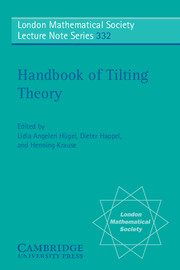Book contents
- Frontmatter
- Contents
- 1 Introduction
- 2 Basic results of classical tilting theory
- 3 Classification of representation-finite algebras and their modules
- 4 A spectral sequence analysis of classical tilting functors
- 5 Derived categories and tilting
- 6 Hereditary categories
- 7 Fourier-Mukai transforms
- 8 Tilting theory and homologically finite subcategories with applications to quasihereditary algebras
- 9 Tilting modules for algebraic groups and finite dimensional algebras
- 10 Combinatorial aspects of the set of tilting modules
- 11 Infinite dimensional tilting modules and cotorsion pairs
- 12 Infinite dimensional tilting modules over finite dimensional algebras
- 13 Cotilting dualities
- 14 Representations of finite groups and tilting
- 15 Morita theory in stable homotopy theory
- Appendix: Some remarks concerning tilting modules and tilted algebras. Origin. Relevance. Future.
7 - Fourier-Mukai transforms
Published online by Cambridge University Press: 25 May 2010
- Frontmatter
- Contents
- 1 Introduction
- 2 Basic results of classical tilting theory
- 3 Classification of representation-finite algebras and their modules
- 4 A spectral sequence analysis of classical tilting functors
- 5 Derived categories and tilting
- 6 Hereditary categories
- 7 Fourier-Mukai transforms
- 8 Tilting theory and homologically finite subcategories with applications to quasihereditary algebras
- 9 Tilting modules for algebraic groups and finite dimensional algebras
- 10 Combinatorial aspects of the set of tilting modules
- 11 Infinite dimensional tilting modules and cotorsion pairs
- 12 Infinite dimensional tilting modules over finite dimensional algebras
- 13 Cotilting dualities
- 14 Representations of finite groups and tilting
- 15 Morita theory in stable homotopy theory
- Appendix: Some remarks concerning tilting modules and tilted algebras. Origin. Relevance. Future.
Summary
Abstract
In this paper we discuss some of the recent developments on derived equivalences in algebraic geometry.
Some background
In this paper we discuss some of the recent developments on derived equivalences in algebraic geometry but we don't intend to give any kind of comprehensive survey. It is better to regard this paper as a set of pointers to some of the recent literature.
To put the subject in context we start with some historical background. Derived (and triangulated) categories were introduced by Verdier in his thesis (see [26, 79]) in order to simplify homological algebra. From this point of view the role of derived categories is purely technical.
The first non-trivial derived equivalence in the literature is between the derived categories of sheaves on a sphere bundle and its dual bundle [70]. The equivalence resembles Fourier-transform and is now known as a “Fourier-Sato” transform.
The first purely algebro-geometric derived equivalence seems to appear in [54] where is it is shown that an abelian variety A and its dual  have equivalent derived categories of coherent sheaves. Again the equivalence is similar to a Fourier-transform and is therefore called a “Fourier-Mukai” transform.
In [7] Beilinson showed that ℙn is derived equivalent to a (noncommutative) finite dimensional algebra. This explained earlier results by Barth and Hulek on the relation between vector bundles and linear algebra. Beilinson's result has been generalized to other varieties and has evolved into the theory of exceptional sequences (see for example [9]).
- Type
- Chapter
- Information
- Handbook of Tilting Theory , pp. 147 - 178Publisher: Cambridge University PressPrint publication year: 2007
- 17
- Cited by



